AI is actively changing how people search. 700 million people use ChatGPT weekly, and Google has introduced AI Mode earlier in 2025 as an alternative to traditional search. This changing landscape requires businesses to treat visibility on AI platforms with as much importance as visibility in organic search.
Monitoring visibility manually is practically impossible. Thankfully, quite a few AI visibility tools have been released this year that automate the process.
This guide will showcase the best options and give suggestions on how to choose an AI visibility tool.
What are AI Visibility Tracking Platforms
An AI visibility tool is an app that measures how visible your brand is on AI platforms like ChatGPT and in AI search features like Google’s AI Overviews. They track hundreds of prompts, look for brand mentions and AI citations, and present a detailed breakdown of your AI brand presence.
There’s a virtually endless number of prompts users can type into an AI chat to find your business because they’re questions, not short phrases like in traditional search. AI search visibility tools track core prompts, phrases that many longer prompts can be reduced to.
For instance, a detailed question like “what are the best productivity tools for a lean startup with eight employees” can be reduced to “best productivity tools for a startup” or “best productivity tools for small businesses.” It’s impossible to track every prompt in existence, but this approach provides the best overview of your position in AI search.
An initial audit of AI visibility is great for understanding your competitive position. Tracking it over a period of time is necessary to judge the success of your optimization efforts.
Choosing the Right AI Search Visibility Tool: Key Considerations
There are plenty of AI visibility tools on the market, each with its unique set of features. Use these criteria to choose the right tool for you.
What AI Engines Does It Cover
The first thing you should look for is what AI platforms this platform can monitor. All AI platforms are slightly different, and searching them will often return slightly different results. Here, for instance, ChatGPT and Perplexity provide two slightly different lists in return for the same prompt.
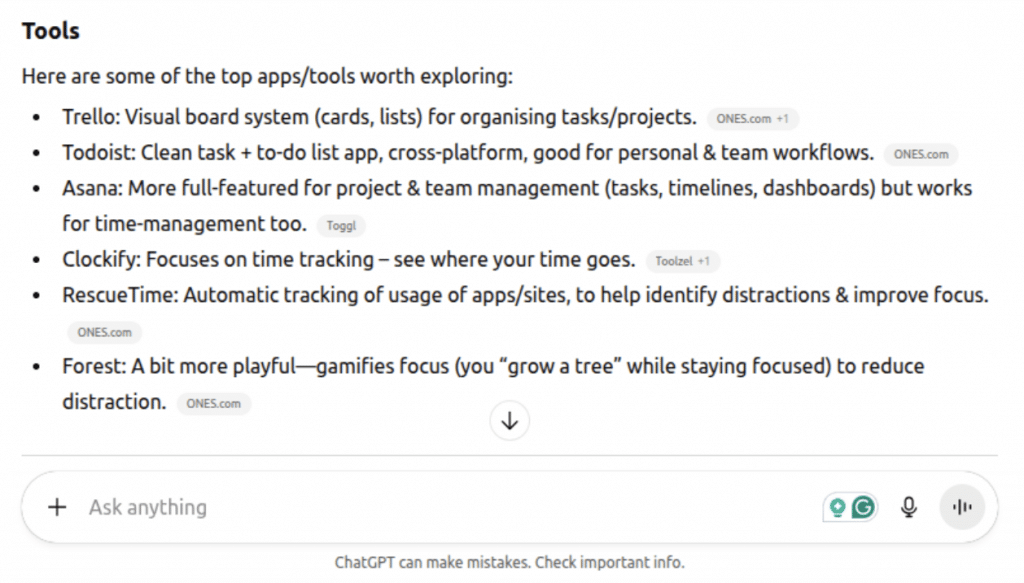
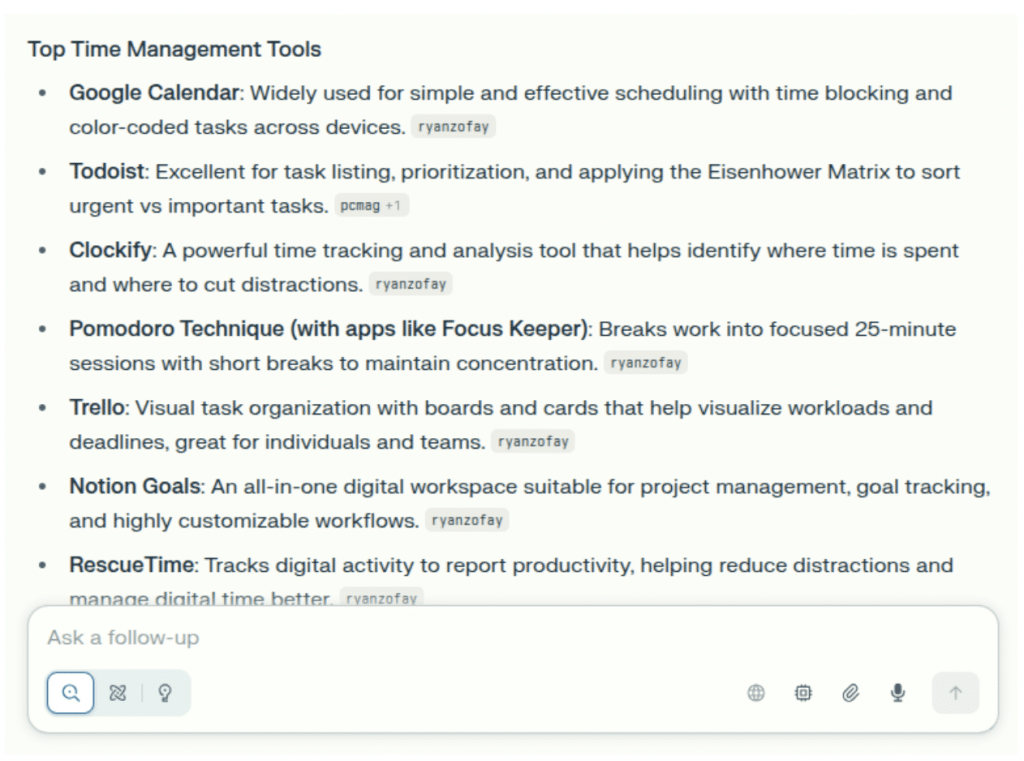
Ideally, your AI visibility tool should cover as many tools as possible. Here are a few AI search engines that you want to see covered in your tool:
- AI Overviews
- AI Mode
- Gemini
- ChatGPT
- Perplexity
These are by far the most popular platforms, and tracking them will provide you with the most relevant AI visibility data.
How It Works With Prompts
Another important part of the best AI visibility tools is the way they work with prompts. Ideally, you want a tool that scrapes AI answers instead of fetching results through the API.
Scraping each answer provides more contextual data. At least in ChatGPT, scraping the app’s UI can return more features from AI answers, like shopping options. API responses don’t have that and may have slightly different phrasing, which can distort the context of your brand mentions.
API might be more reliable, though, as scraping can potentially fail to retrieve data during UI updates.
Additional Features
A lot of AI visibility trackers also offer additional features. Some tools were developed on the basis of traditional SEO tools and can offer multiple optimization features for organic search. Others might offer additional content creation or social listening capabilities.
These features can be a good thing or a bad thing, depending on what your company needs. If you need the additional capabilities an AI visibility tool provides, it’s a good choice because you’ll be saving money by using two sets of features for the same price.
If you already have the tools that cover additional features of an AI visibility tool, you might have to look elsewhere. Especially when the pricing doesn’t reflect the value of the features you do need.
What Metrics Does It Show
An ideal tool should track these metrics:
- Visibility score.
- Breakdown of visibility to mentions and AI citations.
- Positions across all tracked prompts.
- Average position.
- Sentiment score.
It’s best if these metrics are broken down by the AI engine.
Analytics and Insights
The next step is looking at the analytical capabilities of the AI visibility tool. At the very minimum, you want to have access to historical data and competitor research capabilities.
Historical data lets you track your progress in AI visibility optimization. Competitor research helps you understand your relative standing in AI search and analyze competitors that outperform you to improve your strategy.
Some tools can also provide insights into what your next steps should be based on the AI visibility data. Look for those features if you want more help with figuring out strategy.
Integrations
Most AI search visibility tools can be used on their own, without any additional digital infrastructure. If you want them to be a part of your automation infrastructure, look for the ones that have native integrations with the tools you already use.
You can look for:
- Integrations with other analytical tools, like Google Analytics.
- Integrations with automation tools, like Zapier.
- Integrations with reporting and visualization tools, like Looker Studio.
In most cases, you’ll be able to connect AI visibility tools with an API, but that takes more work. Look for native integrations if that’s what’s important to you.
Support
Most tools have a learning curve, and getting some help accessing that curve is crucial for success. The first thing to look for is self-service options. A good AI visibility tool should have a helpful knowledge base, or at least an expanding one. The option of interacting with an integrated AI chatbot to get quick answers about the tool’s functions is also nice to have.
Judging the quality of customer support provided by the representatives is harder without being a customer. Look for negative reviews regarding customer support quality and talk to CS representatives during the trial period if the tool has one.
Scaling Capabilities
The best AI visibility tool won’t have to be abandoned as your company grows. You need the ability to add hundreds of new prompts for brand monitoring if needed. If you run multiple projects, you’ll want the ability to track more than one website.
Scaling the number of tasks you can do with the tool is also important. That can be solved either with the features the tool offers or with native integrations. If it’s a newer tool that’s still in development, look for a clear roadmap of new features and integrations.
Pricing
Finally, take a look at the pricing of the tool you’re interested in. Most SaaS AI visibility tools will have pricing that falls into these three categories:
- Tiered pricing. You pay a fixed rate for a plan that includes spending up to a certain number of credits per month. It’s a very common pricing option.
- Add-on pricing. You pay a fixed rate, but the actual tool is an add-on, so you need to pay a fixed rate for the base tool as well. Good option when you also need the base tool.
- Per usage pricing. You pay for the amount of credits used, typically for the number of prompts you track. Good for gradual growth without jumps in price.
Best AI Visibility Tools
Now that you know what to look for, let’s compare a few of the top-performing AI visibility optimization tools.
| Tool | Starting price | Number of prompts | Free trial | Additional features |
| SE Ranking | $119 | 200 | Yes | SEO toolkit. |
| SE Visible | $189 | 450 | Yes | Price-to-value ratio. |
| Ahrefs | $129 + $199 add-on | N/A | No | SEO toolkit. |
| Otterly | $29 | 15 | Yes | Daily tracking. |
SE Ranking
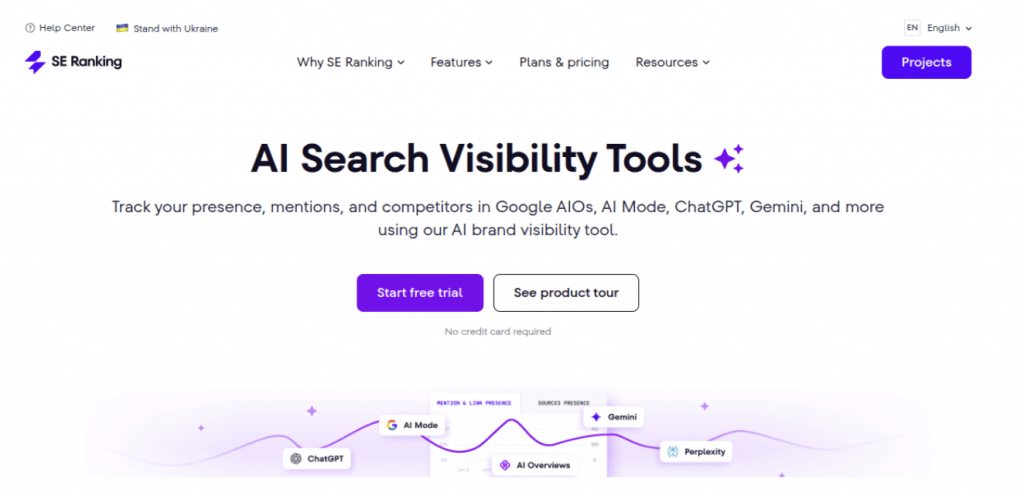
SE Ranking is an SEO-focused platform that offers features like keyword tracking, backlink analysis, content optimization, etc., and expands its coverage to AI visibility tracking. It monitors brand mentions, links, and sources across major AI engines, includes historical metrics, and lets you analyze competitors in AI search.
Basic features:
- Works with AI Overviews, AI Mode, ChatGPT, Gemini, and Perplexity.
- Tracks mentions and links for the chosen prompts, positions, and share of voice.
- Identifies the list of sources AI engines cite most often.
- Offers historical trends and regular data updates.
- Provides AI competitor data.
Unique features:
- Combines SEO and AI search optimization in one platform.
- Offers an API for AI search data.
- Includes cached AI answers to evaluate brand mention context.
Pricing:
- $119 per month for the Pro plan. $259 per month for the Business plan. AI Search add-on pricing starts at $89 per month.
Best for:
SE Ranking is a great choice for SEO specialists, agencies, and businesses that seek one powerful platform for AI visibility tracking and traditional search optimization.
Ahrefs Brand Radar
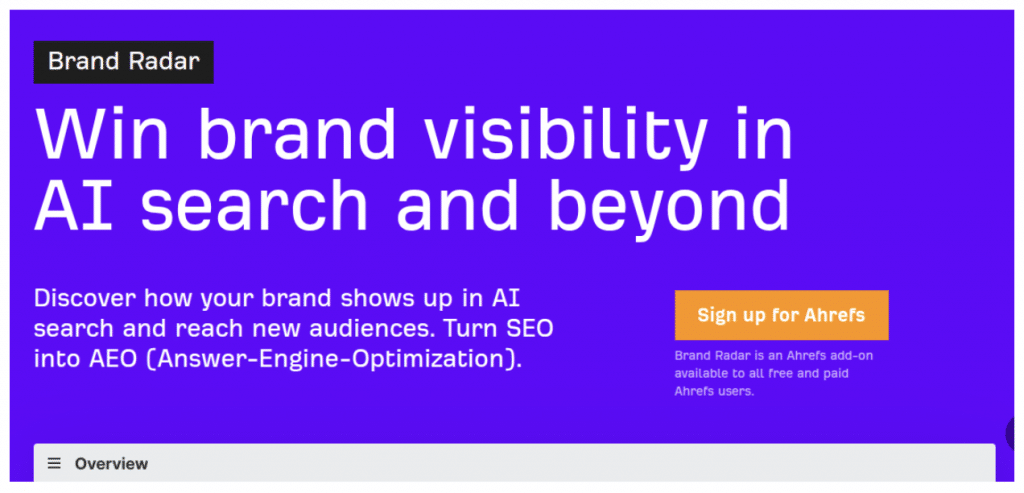
Ahrefs is a well-established SEO tool that offers core search optimization research features, like keyword and backlink analysis. Now it has rolled out an AI visibility tracker tool.
Basic features:
- Tracking visibility across AIO, AI Mode, Copilot, Gemini, Perplexity, and ChatGPT.
- Tracking mentions, impressions, and share of voice.
Unique features:
- A large database of prompts available for tracking.
- Tracking search demand and web visibility.
- A standard suite of traditional SEO tools.
Pricing:
- $129 for the base tool, $199 for the AI visibility add-on.
Best for:
Companies that need an SEO tool with AI visibility tracking features.
Otterly.AI
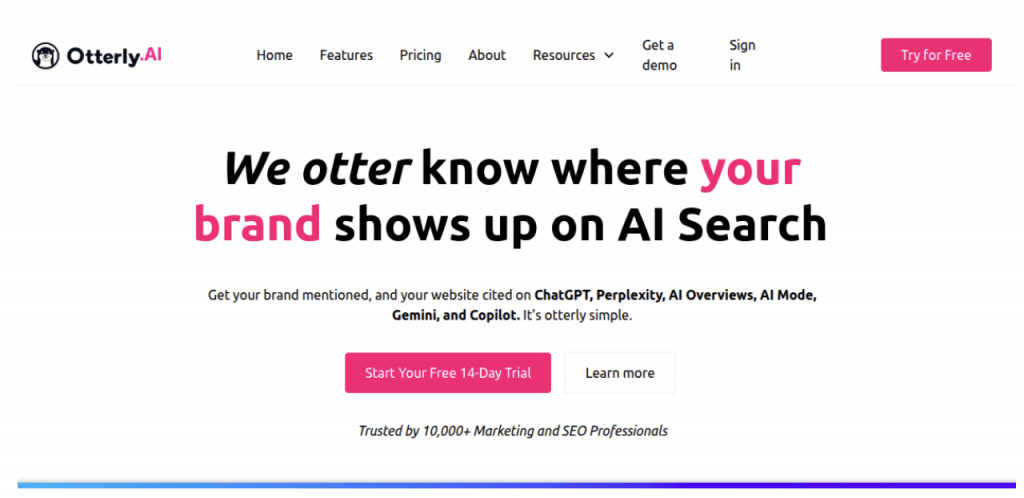
Otterly is a tool for AI visibility only. It can track visibility for the most popular AI search engines daily, even though the number of prompts you can track is on the smaller side.
Basic features:
- AI visibility tracking in ChatGPT, AIO, Copilot, and Perplexity.
- Tracking AI Mode and Gemini are available as add-ons.
- Adding more prompts at $1 per prompt.
Unique features:
- Daily tracking.
- Unlimited user seats.
- Keyword research tool.
Pricing:
- $29 for 15 prompts.
Best for:
Companies that are starting out with AI visibility research and want a standalone tool.
How to Choose an AI Visibility Tool for Your Brand
Let’s look at two major factors that play a role in whether a particular tool is not only good, but right for your specific business.
Alignment With Your Goals
The first factor you should consider is how well the tool aligns with your goals. The quality of the basic AI visibility tracking features is important, but you’ll want high quality here regardless of your goals. Look for additional features in the perfect tool.
For instance, if you also need social listening or search engine visibility tracking, go for tools that offer that on top of AI search visibility monitoring. If you want to speed up the decision-making process in AI search optimization, go for tools with more analytical capabilities.
Budget Considerations
Once you narrow down your search, compare the pricing of different AI visibility tracking tools. The main questions you need to answer are:
- Does the value you receive justify the price?
- Do the existing payment options fit your usage goals?
- Does the pricing allow for smooth scaling?
If all three answers are positive, this AI visibility tool is right for you.
Summary
Conversational AI will probably not make Google search and organic search optimization obsolete. But it will also not fade into obscurity. It has become a sizeable part of how people look up information online, and is likely to grow in popularity in the coming decade.
Treat it as what it is, a new way to experience the web, not as a trend. Start optimizing for AI visibility now to beat the crowd of competitors who are going to be joining the race soon. Choosing an AI visibility tool is your first step towards that.
Choose one from the list in this article and get a free trial to see your brand presence in AI.
Last Updated on November 11, 2025